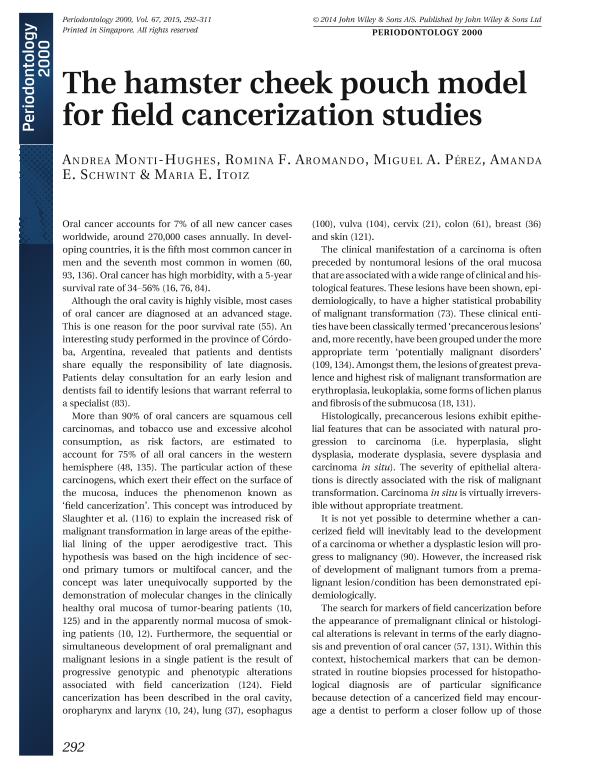Artículo
The hamster cheek pouch model for field cancerization studies
Monti Hughes, Andrea ; Aromando, Romina Flavia; Pérez, Miguel A.; Schwint, Amanda Elena
; Aromando, Romina Flavia; Pérez, Miguel A.; Schwint, Amanda Elena ; Itoiz, María Elina
; Itoiz, María Elina
 ; Aromando, Romina Flavia; Pérez, Miguel A.; Schwint, Amanda Elena
; Aromando, Romina Flavia; Pérez, Miguel A.; Schwint, Amanda Elena ; Itoiz, María Elina
; Itoiz, María Elina
Fecha de publicación:
02/2015
Editorial:
Wiley Blackwell Publishing, Inc
Revista:
Periodontology 2000.
ISSN:
0906-6713
Idioma:
Inglés
Tipo de recurso:
Artículo publicado
Clasificación temática:
Resumen
External carcinogens, such as tobacco and alcohol, induce molecular changes in large areas of oral mucosa, which increase the risk of malignant transformation. This condition, known as ‘field cancerization’, can be detected in biopsy specimens using histochemical techniques, even before histological alterations are identified. The efficacy of these histochemical techniques as biomarkers of early cancerization must be demonstrated in appropriate models. The hamster cheek pouch oral cancer model, universally employed in biological studies and in studies for the prevention and treatment of oral cancer, is also an excellent model of field cancerization. The carcinogen is applied in solution to the surface of the mucosa and induces alterations that recapitulate the stages of cancerization in human oral mucosa. We have demonstrated that the following can be used for the early detection of cancerized tissue: silver staining of nucleolar organizer regions; the Feulgen reaction to stain DNA followed by ploidy analysis; immunohistochemical analysis of fibroblast growth factor‐2, immunohistochemical labeling of proliferating cells to demonstrate an increase of epithelial cell proliferation in the absence of inflammation; and changes in markers of angiogenesis (i.e. those indicating vascular endothelial growth factor activity, endothelial cell proliferation and vascular density). The hamster cheek pouch model of oral cancer was also proposed and validated by our group for boron neutron capture therapy studies for the treatment of oral cancer. Clinical trials of this novel treatment modality have been performed and are underway for certain tumor types and localizations. Having demonstrated the efficacy of boron neutron capture therapy to control tumors in the hamster cheek pouch oral cancer model, we adapted the model for the long‐term study of field cancerized tissue. We demonstrated the inhibitory effect of boron neutron capture therapy on tumor development in field cancerized tissue with acceptable levels of mucositis, a dose‐limiting side‐effect.
Palabras clave:
Cancer
Archivos asociados
Licencia
Identificadores
Colecciones
Articulos(SEDE CENTRAL)
Articulos de SEDE CENTRAL
Articulos de SEDE CENTRAL
Citación
Monti Hughes, Andrea; Aromando, Romina Flavia; Pérez, Miguel A.; Schwint, Amanda Elena; Itoiz, María Elina; The hamster cheek pouch model for field cancerization studies; Wiley Blackwell Publishing, Inc; Periodontology 2000.; 67; 1; 2-2015; 292-311
Compartir
Altmétricas



